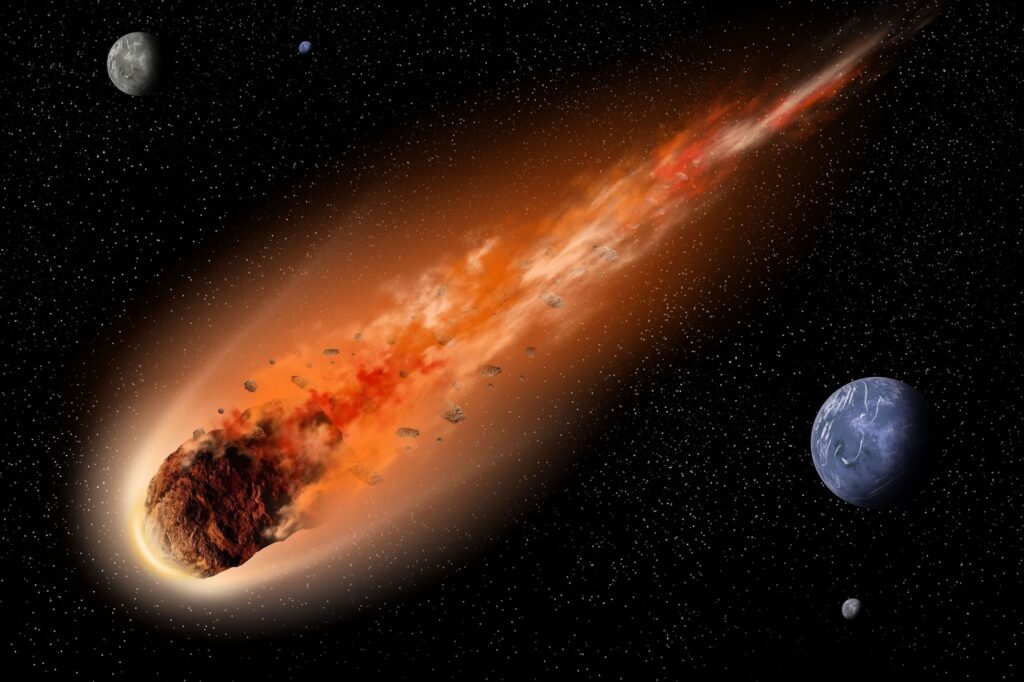Asteroids
An asteroid is a small, solid object in our Solar System, orbiting the Sun. An asteroid is an example of a minor planet (or planetoid), which are much smaller than planets. Most asteroids are believed to be remnants of the protoplanetary disc which were not incorporated into planets during the system’s formation. Some asteroids have moons. The vast majority of the asteroids are within the main asteroid belt, with elliptical orbits between those of Mars and Jupiter.

The term “asteroid”, meaning star-like was coined in 1802 by Sir William Herschel shortly after Olbers discovered the second one, 2 Pallas, in late March of the same year, to describe their star-like appearance; the other then-known planets all show discs, by comparison.
He also applied that term to the small moons of the giant planets. The first scientific paper to use the word in its title was published in 1840 by Erman.
The exact definition of an asteroid is unsettled. The term “Minor planet” carries no strong suggestion about the composition of the object or its general location in the solar system, and some argue that not every minor planet should be called an “asteroid“.
One way to classify asteroids is in terms of size. A working definition is that asteroids are larger than 50 m in diameter, distinguishing them from meteoroids, which are typically boulder-sized or smaller. The distinction is made because asteroids are large enough to survive passage through Earth’s atmosphere and strike Earth largely intact while the smaller meteoroids generally break up high in Earth’s atmosphere.
Thus, it would be safest to use the term “asteroid” for Solar System objects that are bigger than meteoroids, smaller than planets, and made out of rock, not ice. See Solar System for a complete taxonomy of objects in our system, and minor planet for taxonomy of the sub planetary objects that include asteroids. The term artificial asteroid is sometimes used to designate man-made objects which have ended up in solar orbits, such as the Mariner IV probe.
Asteroids in the Solar System
Hundreds of thousands of asteroids have been discovered within the solar system. As of October 19, 2005, from a total of 299,733 minor planets with calculated orbits, 118,161 asteroids had been calculated well enough to be given official numbers and 12,712 of these had been officially given trivial names to go along with the numbers (at least 610 of which have names requiring diacritics). The lowest-numbered but unnamed minor planet is (3360) 1981 VA; the highest-numbered named minor planet is 99942 Apophis.
The Minor Planet Circular (MPC) of October 19, 2005 was a historical one, as it saw numbered asteroids jump from 99947 to 118161, causing a small “Y2k” like crisis for various automated data services —up until then, only five digits were allowed in most data formats for the asteroid number. (This was solved in some data fields by having the leftmost digit, the ten-thousand places, use the alphabet as a digit extension. A=10, B=11… Z=35, a=36… z=61. The highest number 118161 thus is cross-referenced as B8161 on some lists.)
Current estimates put the total number of asteroids in the solar system at several million. The largest asteroid in the inner solar system is 1 Ceres, with a diameter of 900-1000 km. Two other large inner solar system belt asteroids are 2 Pallas and 4 Vesta; both have diameters of ~500 km. Vesta is the only main belt asteroid that is sometimes visible to the naked eye .The mass of all the asteroids of the Main Belt is estimated to be about 2.3×1021 kg, or about 3% of the mass of our moon. Of this, 1 Ceres comprises 940 to 950×1018 kg, some 40% of the total. Adding in the next three most massive asteroids, 4 Vesta (12%), 2 Pallas (9%), and 10 Hygiea (4%), bring this figure up 66%; while the three after that, 511 Davida (1.6%), 704 Interamnia (1.4%), and 3 Juno (1.2%), only add another 4% to the total mass. The number of asteroids then increases exponentially as their individual masses decrease.
Asteroid Exploration
Until the age of space travel, asteroids were merely pinpricks of light in even the largest telescopes and their shapes and terrain remained a mystery.
The first close-up photographs of asteroid-like objects were taken in 1971 when the Mariner 9 probe imaged Phobos and Deimos, the two small moons of Mars, which are probably, captured asteroids. These images revealed the irregular, potato-like shapes of most asteroids, as did subsequent images from the Voyager probes of the small moons of the gas giants.The first true asteroid to be photographed in close-up was 951 Gaspra in 1991, followed in 1993 by 243 Ida and its moon Dactyl, all of which were imaged by the Galileo probe en route to Jupiter.
The first dedicated asteroid probe was NEAR Shoemaker, which photographed 253 Mathilde in 1997, before entering into orbit around 433 Eros, finally landing on its surface in 2001. Other asteroids briefly visited by spacecraft en route to other destinations include 9969 Braille (by Deep Space 1 in 1999), and 5535 Annefrank (by Stardust in 2002).
In September 2005, the Japanese Hayabusa probe started studying 25143 Itokawa in detail and will return samples of its surface to earth. Following that, the next asteroid encounters will involve the European Rosetta probe (launched in 2004), which will study 2867 steins and 21 Lutetia in 2008 and 2010. NASA is planning to launch the Dawn Mission in 2006, which will orbit both 1 Ceres and 4 Vesta in 2010-2014.
Solar System | Mercury | Venus Moons | Earth | Mars Moons | Jupiter Moons | Saturn Moons | Uranus Moons | Neptune Moons | International Space System | ISS Research | Moons of the planet | Magnetosphere | Regions Of Comets | Space Station Glossary | Space Station Abbreviation | Space Station Sitemap | Asteriods | Contact Us